 |
Traditionalist Issues
Crisis in Catechesis
Fr. Stephen Somerville
Do you remember that Gospel incident when Jesus, aged 12, was lost for three days, and was found by His parents in the great Temple at Jerusalem? He was discussing with the doctors of the holy Mosaic Law. He was only 12. They were amazed at His wisdom and His answers to their questions.
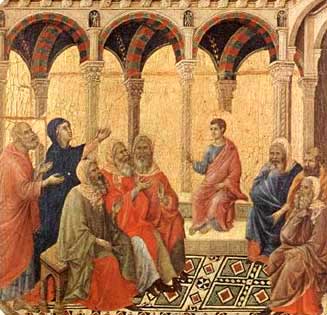
Jesus discussing with the doctors in the Temple
Duccio di Buoninsegna, 13th century |
But Mary had a shock of relief at finding her Son safe. She spoke to Jesus rather as if He had never been away from her before. “Son, why hast Thou done so to us? Behold, Thy father and I have sought Thee sorrowing!” St. Luke goes on to assure us that Jesus went back to Nazareth with Mary and Joseph and – I quote – “that He was subject to them!” That means obedient and respectful. The Evangelist also notes this sequel: “And Jesus advanced in wisdom and age and grace before God and men” (Lk 2:49-52).
Notice that there is no mention here or anywhere else of Jesus attending a school. We rather suspect that He never did go to any earthly school. We know that He could talk with His heavenly Father and the Holy Ghost at any time. His holy Mother, brought up in the Temple, had been trained in the Law of Moses. This included the celebrated Ten Commandments and many more rules of good conduct, morality, and justice for the Jews to observe. Jesus certainly did not need earthly school training.
Catechesis in the Old Covenant
What about the Jewish children of other couples? Did God command that there be a Jewish school system for the Hebrew boys and girls? Did God want those children to learn His laws and obey them? Did He have some teachers in mind who would pass on to children the laws of God specially revealed to Israel by the great lawgiver Moses?
The answer to all these questions is: Yes. The parents were the ones who would teach God’s laws to those children.
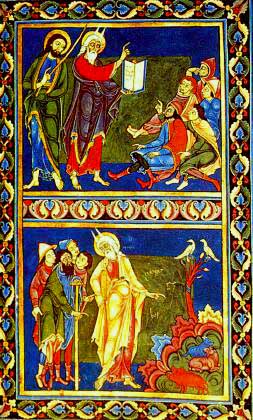
Moses teaching the Israelites
Bury Bible 12th century |
Let us go back to the formative years of Israel when, led by the great Moses, they were tramping across the Mount Sinai desert toward the Promised Land beyond the Jordan River. This story is told in the Pentateuch, that is, the first five books of the Bible, starting with the Genesis.
The fifth of these books is Deuteronomy. In chapter 4, Moses says:
* “O Israel, hear the precepts which I teach thee …. You shall not add to the word that I speak to you, neither shall you take away from it.” (v.2)
* “Forget not the words (of the law) …. Thou shalt teach them to thy sons and grandsons … (let the people) teach their children.” (v. 9-10)
* “Put these words in your hearts and minds … teach your children that they might meditate on them, when thou sittest in thy house, and walkest on the way, and liest down to rest.” (11:19)
* “Thou shalt write my words on the posts and gates of thy house, that thy days may be multiplied and the days of thy children” (20-21).
In chapter 32, Moses delivers his famous Canticle of the Law, “Hear, ye heavens, the things that I speak…” He concludes saying to all the people:
“Set your hearts on the words which I testify to you this day, that you command them to your children to keep and to do, and to fulfill all things of this law that are written.” (32:36)
Notice that the law of God is written, as well as delivered, taught, meditated on, kept and done. What are these exhortations by Moses? It is a scriptural witness to home-schooling.
Let us conclude with a citation from the Book of Ecclesiasticus:
“He that teachest his eldest son will be praised in him, and in the midst of his family he shall glory in him. (When he dies) he will have left behind him one like to himself.” (30:2-4)
Did the ancient Hebrew people remain content with this home-schooling of their children in God’s Laws? Was teaching by parents the only kind of instruction among them? No, not at all.
As the Jews became more settled in the land and more advanced in education, they developed professional teachers and schools for various purposes. But I hope that the Jewish fathers and mothers never forgot that wise, holy and inspired urging of Moses to teach their children the laws of God.
So much for old Israel.
Role of the Catholic schools
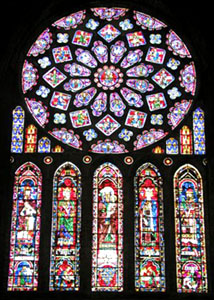
The medieval stained glass windows were catechism classes Chartres Cathedral |
We come now to the New Israel of God, St. Paul’s inspired name for the Holy Catholic Church. How should the Church transmit to her young children the knowledge of the New Law, that is, the Gospel, from the New Moses, that is, Jesus?
This is not the place or time to give you a complete history of Catholic Education. It would be a marvelous story. The fantastic stained-glass windows of those soaring medieval Cathedrals are a standing sermon and instruction on the Catholic mysteries at a time when not all people had the advantage of literacy and schooling.
In time, especially after the Protestant Revolution, Catholic religious orders sprang up. Their main work was to teach the Faith, especially to children and adolescents. Remember that the first universities in Catholic Europe were the fruit of Catholic teaching orders in the Middle Ages. Coming down to our own times, we have become accustomed to having some system of Catholic schools at primary and secondary level, at least in recent past, depending on the ups and downs of the Church in the secular society in which we live.
These Catholic schools used to teach catechism, using short, memorized questions and answers, still in the living memory of today’s older generation. This traditional catechesis was very effective when taught by good religious. I learned it myself, and during my childhood in the '40s and '50s, most of our school teachers were zealous religious, far outnumbering the lay Catholic teachers.
After Vatican II, a revolution in Catechesis
Since the 1960s and Vatican II, the story is different and disturbing. A revolution has overtaken Catholic catechesis and theology, just as it has in liturgy and faith. One symptom is the loss of clear content, of firm knowledge. After several years of Catholic schooling, our pupils seem to know hardly anything definite. They spend time on the history of other religions, but seem to neglect their own Catholic Faith. They hear little of knowledge, duty and heritage. It is experience, attitude and feeling that have become the important words.
But, the new teachers say, “These are merely subjective things,” meaning that they are in me, rather than stable objective things, outside myself.
Some truths are ignored or denied. For example, angels and devils are portrayed as mere symbols, not real spiritual beings. The priest is mainly a facilitator and counselor, not a true, hieratic offerer of sacrifice. The Real Presence is only a symbol of Christ, and the Incarnation of God in Jesus Christ is to be questioned. First Confession is not important and should take place a year or so after First Communion. Adoration of the Host is rather absurd. Miracles did not happen, but were stories invented by early Christians to make Jesus and the Church look compelling and divine. The inspiration of the Bible is a myth; the Bible can be explained by natural and rational causes and processes. And so on and so on.
These are some of the religious falsities that are taught or at least suggested to Catholics in our post-modern times, starting mainly in the 1960s. They all contradict Catholic Tradition, and violate many of the defined dogmas of our Faith.
How did these false ideals arise? Where do they come from? Are they a consistent, organized, deliberate body of opinion that has a name? Why did the Popes since John XXIII (who died in 1963, one year after the start of the Second Vatican Council) allow these wrong ideas to invade the Catholic Church? Did these Popes also agree with these modern and false opinions? What can we do to resist and correct the contemporary flow of heresy? How can we protect our children from it?
These are some of the questions that sensible Catholics should ask and strive to answer. To bring to a conclusion these considerations on catechesis, faith and home-schooling, let us draw up a few answers.
Heretical bishops and theologians
First, let us admit frankly that from God’s point of view we are facing a worldwide loss of Faith that frequently amounts to a rejection of that Faith. We can call this a true apostasy, and the phrase “silent apostasy” or “creeping apostasy” has been heard from the Vatican, particularly regarding Europe. Pope Paul VI spoke of the smoke of Satan in the sanctuary, and of the auto-destruction of the Church back in the 1970s. Jesus Himself predicted in Matthew 24 that many false Christs and false prophets would arise and deceive many; not a few but many. I see the false Christs as the heretical bishops and the false prophets as the heretical theologians, especially those who were leaders during and after the Vatican II Council.
Jesus once asked rhetorically, “When the Son of Man comes, do you think He will find any faith on the earth?” St. Paul also predicts this rebellion led by the Antichrist, the man of sin, in 2 Thessalonians, chapter 2, all sixteen verses. You should read and ponder this passage. It is the only passage of St. Paul that has been suppressed in the new lectionary.
Some of the many evils
From the point of view of human philosophies, the Church today is engulfed in a wave of liberalism, modernism, mobilism, and probably another half-dozen of these anti-Catholic “isms.” These have been festering the world around us for a long time, especially since the French Revolution of the 1790s, which cruelly killed the King and nobles, as well as thousands of priests, monks, nuns and other Catholic faithful. Since then, good Popes have striven to protect and arm the Church against worldly evil by closing the Church’s doors and windows to the foul air outside.
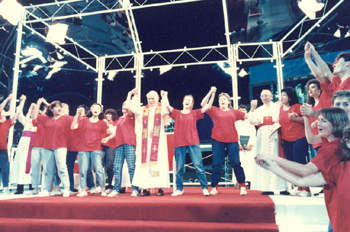
Aggiornamento: JPII dances to rock with youth in Australia [another photo] |
But John XXIII around 1960 opened the windows to let in, as he proposed, good fresh air and aggiornamento, or “updating.” The results, as we all can see, have been tragic.
Let me briefly describe those dangerous isms.
Liberalism is an exaggerated promotion of liberty. It means that man is “at liberty” to believe or disbelieve what he likes about religion and God. Only science can demand his assent. Religious opinions are irrelevant to real life and government, religion should remain a private matter. Such is Liberalism. It leads, of course, to Atheism, the denial of God.
Modernism is the Zeitgeist, the spirit of the times. It tends to be a catch-all, a grab-bag of all the past heresies rolled into one. So we were taught by Pope St. Pius X who wrote a magnificent encyclical against Modernism. Its name is Pascendi Dominici gregis. It is regularly ignored by modern and modernist theologians. We sometimes speak of the so-called New Theology in the Church. It usually is more or less modernist.
This leads us to Mobilism. The word implies movement, growth, change, evolution, searching, striving. It is a philosophical notion that considers everything to be in flux and not stable or firm. From a physical science view, there is much truth in this. From a spiritual and theological view, it is false and disastrous. Mobilism says becoming is better than being, motion is better than rest, action is better than the goal. The fullness and perfection of God is irritating, if not incomprehensible to a mobilist thinker.
Because of these isms, these currents of worldly philosophy, the contemporary religious educator hates the traditional catechism. He calls the memorization of short questions and answers mere parroting. He ridicules simple definitions as being rigid and narrow and closed to further thought. He says that searching for God is better than possessing Him. He says that choosing or shaping your own religion is better than accepting one from above, whether from a faithful teacher, or from the Church, or from God. What colossal pride in foolish men that they should try to choose or construct a better religion than the one, holy, Catholic religion brought down from Heaven to earth by the Lord Jesus after due preparation by His forerunner Prophets.
Jewish and Masonic infiltration in the Church
There is another, more concrete and malevolent attack on the Catholic Church, aiming to destroy her from within. I am alluding to the infiltration of the Catholic seminaries and religious houses in the mid-twentieth century by young men posing as pious, intelligent Catholics, and previously schooled for this fifth-column work by the Freemason and B’nai B’rith.
Perhaps you have read the book AA-1025, the detailed diary of one of these infiltrators, who was killed in a street accident. His diary was discovered in his briefcase by Marie Carre, a Catholic nurse at the hospital where his body was taken by ambulance. It was subsequently published for our warning.
I heard the account about another infiltrator in the seminary in my own city of Toronto. He had been receiving suspect-looking mail, was investigated, and promptly expelled. He walked out shouting brazenly, “You have caught me, but you won’t catch a thousand others!”
Another book relevant to this is the Alta Vendita, from the late 19th century. It is a detailed manual on how to corrupt and confuse; how to dislodge and destroy the religious faith of Catholics. It was a secret publication of the Freemasons, for the guidance of their undercover agents. The Alta Vendita was discovered and reported to Pope Pius IX, who authorized its republication for Catholics, to alert them to the Masonic danger.
Solution: Prayer and traditional teaching
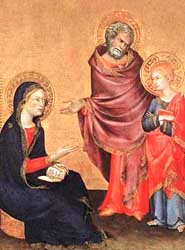
Returned to Nazareth
Simone Martini, 13th century |
What can we do to stand firm against his vast, and pervasive diabolical turmoil, active in the world and assailing the Church in our time? In particular, how must we resolve the crisis that has struck religious education and catechesis?
We heard that the young Child Jesus went down to Nazareth with Mary and Joseph, and was subject to them. We can go down on our knees to Jesus, Mary and Joseph, and be subject to their heavenly support, light and grace.
We heard of Patriarch Moses teaching the laws of God in the Pentateuch Books and exhorting us to teach these laws to our children. We can teach the new and perfect Gospel laws of Jesus, the new Moses, by means of the time-tested Baltimore Catholic Catechism, or other traditional catechism.
We can utilize the great and growing strength of Catholic home-schooling. We can continue steadfast in the faithful remnant of the Catholic Church, with her Catholic Faith and Catholic Sacraments.


Related Topics of Interest
 Liberalism, Modernism and Progressivism Liberalism, Modernism and Progressivism
 Revolution and Counter-Revolution Revolution and Counter-Revolution
 St. Leo II Condemned Pope Honorius as a Heretic St. Leo II Condemned Pope Honorius as a Heretic
 Doubts about the Sanctity of John XXIII Doubts about the Sanctity of John XXIII
 Declaration of Resistance to the Vatican Ostpolitik Declaration of Resistance to the Vatican Ostpolitik
 Conservatives, Traditionalists, and Counter-Revolutionaries Conservatives, Traditionalists, and Counter-Revolutionaries

Related Works of Interest
|
Traditionalism | Hot Topics | Home | Books | CDs | Search | Contact Us | Donate

© 2002- Tradition in Action, Inc. All Rights
Reserved
|
 |
|